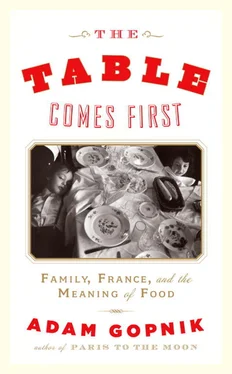The Fooding restaurant guide is the most obvious of the group’s activities. Since its founding, in 2000, by Alexandre Cammas and Emmanuel Rubin, two gastronomic journalists exasperated by the conformity and conservatism of French food culture, Le Fooding has published, from its Right Bank offices, a handsome, atypically larksome, and unusually honest annual encyclopedia of the restaurants and bistros of both Paris and the provinces. (The guide boasts on its cover that its writers pay their own checks and can prove it—not a thing universally true of French food guides.) But the guide is, in a sense, merely the word, not the act, of the enterprise. The movement, which has been reinforced over the years by a constantly changing team of other Fooding-istes, also sponsors mass picnics—“Foodings”!—at which three-star French chefs, long separated from their diners by a kitchen door and centuries of decorum, offer good food in casual, high-spirited settings. These Foodings take place all over France; the atmosphere is somewhere between a buffet dinner and the Woodstock festival.
Le Fooding is in part a move to épater la bourgeoisie —it was at a Fooding event that the young chef Petter Nilsson famously assembled a plate of vegetables that symbolized the world’s religions, with a giant frite in the shape of a cross on top—but it has also been accused, by left-wing journalists, of representing the bourgeoisie; the populist left-wing magazine Marianne charged that it was a kind of cosmopolitan fifth column in the continuing modern assault on French values, and Emmanuel Rubin left the movement last year, disillusioned by what he considered its loss of moral mission.
I first heard about Le Fooding in an e-mail from Raphaël Glucksmann, the filmmaker and human-rights activist (and the son of the philosopher André Glucksmann). “For once, I’m not writing on behalf of the Chechens, the Rwandans, or the Georgians,” he explained cheerfully, and then urged me to meet with his friend Zoé Reyners, who was coming to New York as a kind of avant-garde of the Fooding movement here. Zoé turned out to be an exquisite, nervous blonde in white linen, with a distinct resemblance to the young Brigitte Fossey, and she explained that Le Fooding was planning to come to New York for its first American event, a marriage of art, food, and festival that would be called Le Fooding d’Amour and would take place on the grounds of P.S. 1 in Queens, creating a kind of Lafayette-Washington moment. The best of the new generation of French chefs were flying in to meet the best of the new generation of Americans and cook alongside them. She gave me a copy of the latest Fooding guide, which was illustrated by the young cartoonists who bring so much life these days to French journalism. The cover showed King Kong ripping the dome from a Haussmannian restaurant palace with a look of utter satisfaction as he eats the bourgeois diners inside with an enormous silver spoon. The tone of the reviewing had a jocose quality quite new in France: the section on three-star-style temples was called “Fais-Moi Mal!”—literally, “Make Me Ache!” or, idiomatically, “Hurt Me!” Zoé asked if I’d like to meet Alexandre Cammas, who was arriving in New York the following month for an extended reconnaissance of the new world. “He will be taking a house in Brooklyn, with his family, in order to lay the groundwork for American Fooding,” she said.
I met Alexandre, with Zoé, in Bryant Park; he turned out to be the Danton of the Fooding movement, one of those passionately articulate young Frenchmen who speak with the relentless eloquence of French letters and philosophy, answering each rhetorical question as they raise it. “Fooding?” he said. “I was writing for the magazine Nova , and I needed a rhyme for the title of a piece.” We had now settled on a bench. “I intended the word as a mélange of ‘food’ and ‘feeling’—and I like the provocation of using an English word within the context of French cuisine,” he explained. “I was already a food writer—I had been at Libération for a while—and this was in 1999, a time when restaurants in France were already beginning to move, to change. There was a new element of design, a new element of casual yet serious food. The old choice between la cuisine de bistrot and la grande cuisine française was ending.
“I wasn’t, in the beginning, trying to do anything except characterize a little phenomenon—but I found it growing, in response to a new need.” He cleared his throat and leaned forward, like one who needs to resolve complexities that his innocent listener hasn’t even grasped yet. “What does it mean, the Fooding movement?” he went on. “Food and feeling—that’s the heart of it. But with what practical effect? ‘Feeling’ in the sense that we mean to be part of le goût de son temps —the taste of one’s time, though ‘taste’ in English is too weak a word. ‘Fooding’ means to eat and drink with feeling—to recognize that one eats with the nose, the eyes, and the mouth, with everything that makes us human! At the time we began, French culinary journalism was narrowly focused on the cooking of the kidneys, the tenderness of the poularde. What was on the plate was all that counted! But who lives that way? Who eats that way? We wanted cooks who cooked with the whole of their selves and souls, not technicians of the table. French cuisine was caught in a museum culture: the dictatorship of a fossilized idea of gastronomy. And this dictatorship has been enforced by tourism: you have tourists packing in to experience gastronomy in a kind of perpetual museum of edification. We wanted to be outside that, sur le pont , on the bridge, in front, defining everything that is new. We wanted to escape foie gras, volaille de Bresse , all the clichés.”
He caught himself, bad-mouthing foie gras being a bit like bad-mouthing the Communion wafer: “Not that we have anything against it—we adore foie gras, and who doesn’t love poulet de Bresse ? But all this style that had been mechanically copied over and over—it’s not living cuisine. In a living cuisine, things move and mix together, and that’s what makes the cuisine of tomorrow. The classic French cuisine was dying. Everyone knew it outside of France, but it had to be said within. And it had to be said with joy—not as something to mourn but as something to celebrate, the beginning of a new taste of one’s time.”
Alexandre and Zoé went on to explain that the movement first made its mark with the publication of the guide, which immediately became notorious for ignoring some great names, like the restaurateur Guy Savoy, and honoring such masters as Alain Ducasse for their casual fusion places rather than for their grand restaurants. “We left out Guy Savoy not because he is not a fine cook but because he was adding nothing new,” Alexandre explained. “We want food to be a series of provocations, not mechanical pleasures. Food must belong to its time.”
I asked Zoé and Alexandre whom they would include on their list of Fooding chefs in Paris, and wondered if I might have lunch at a Fooding restaurant with a Fooding guru the next time I was over. Zoé mentioned a few places, including Stéphane Jégo’s L’Ami Jean, a small Basque bistro in the Seventh Arrondissement; Yves Camdeborde’s Le Comptoir, a twenty-seat dining room in the Hôtel Relais Saint-Germain; and Bruno Doucet’s La Régalade, a bistro out near the Porte de Châtillon.
Both Zoé and Alexandre had the warm glow of revolutionary sectarians in their eyes, and, having shared their fond exasperation with the stasis of French cooking, I was inspired. At the same time, their desire for a head-to-toe, well-articulated renewal of French cuisine, complete with a guide and an advance guard of agitators, seemed a peculiarly calculated way of achieving increased spontaneity. The systematic, thought-through approach to a renaissance in casualness might itself be a symptom of the problem, it occurred to me, as though they were saying to one another, If only we could persuade our countrymen to stop being so entirely French, we could persuade them to be entirely French.
Читать дальше












